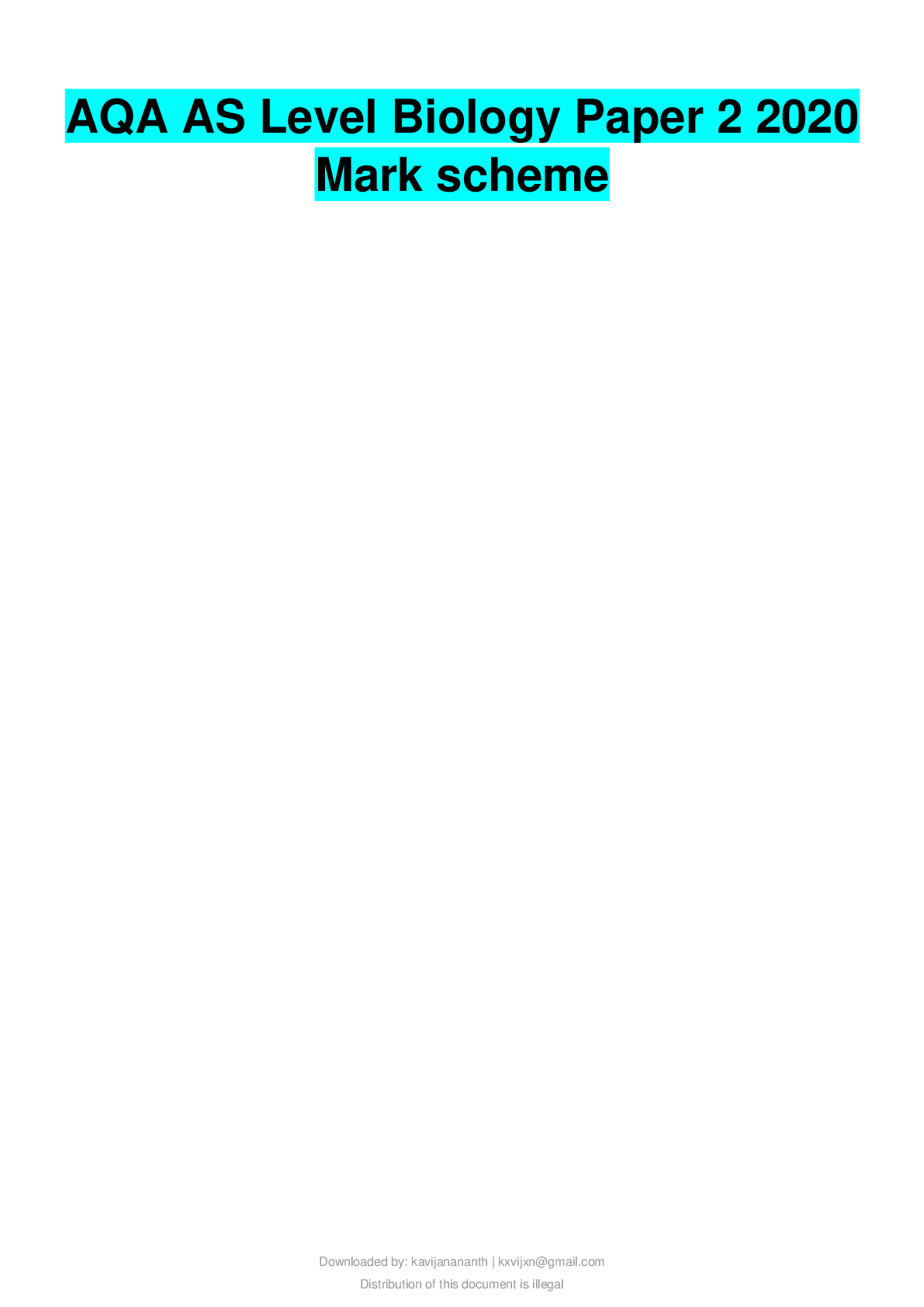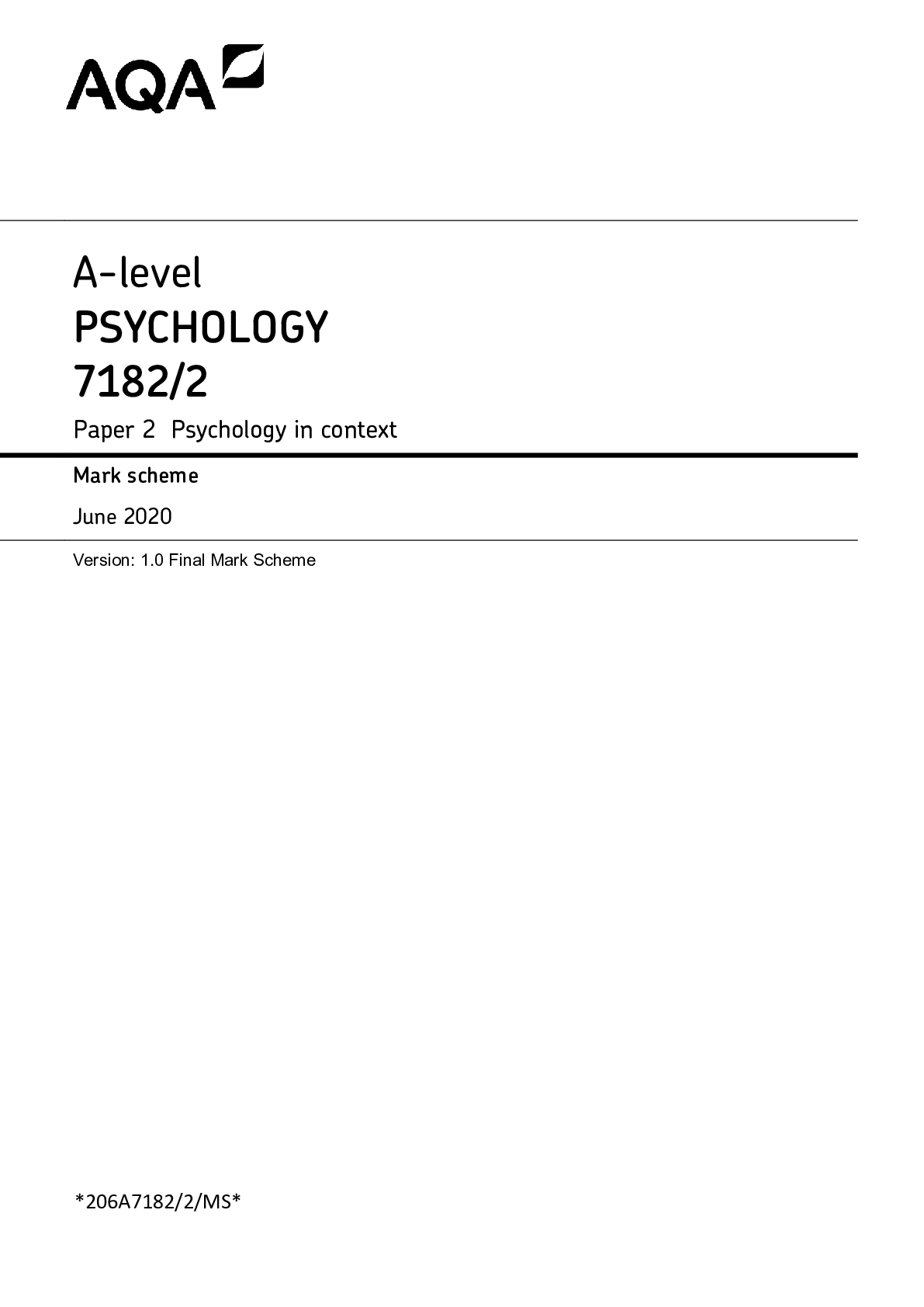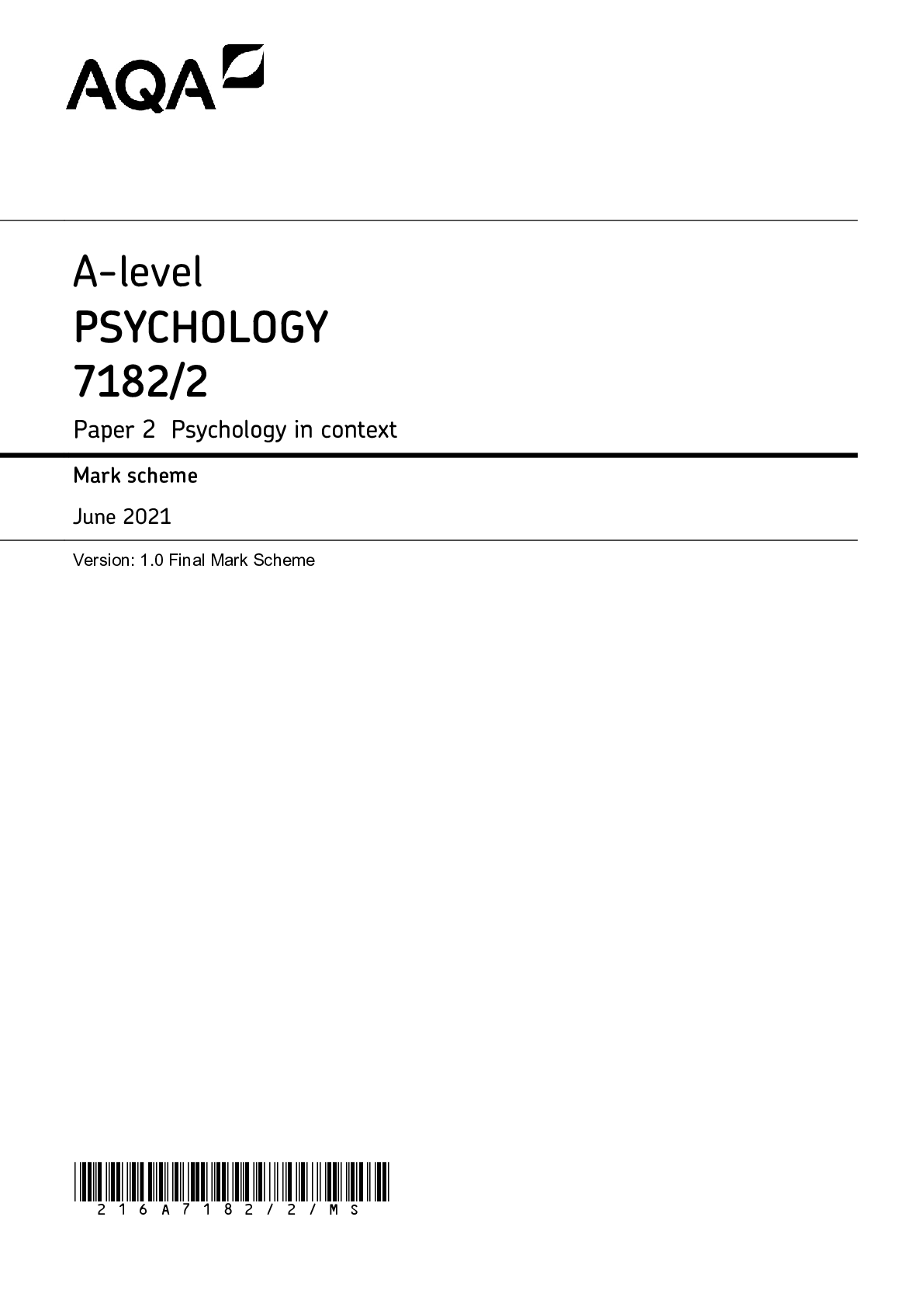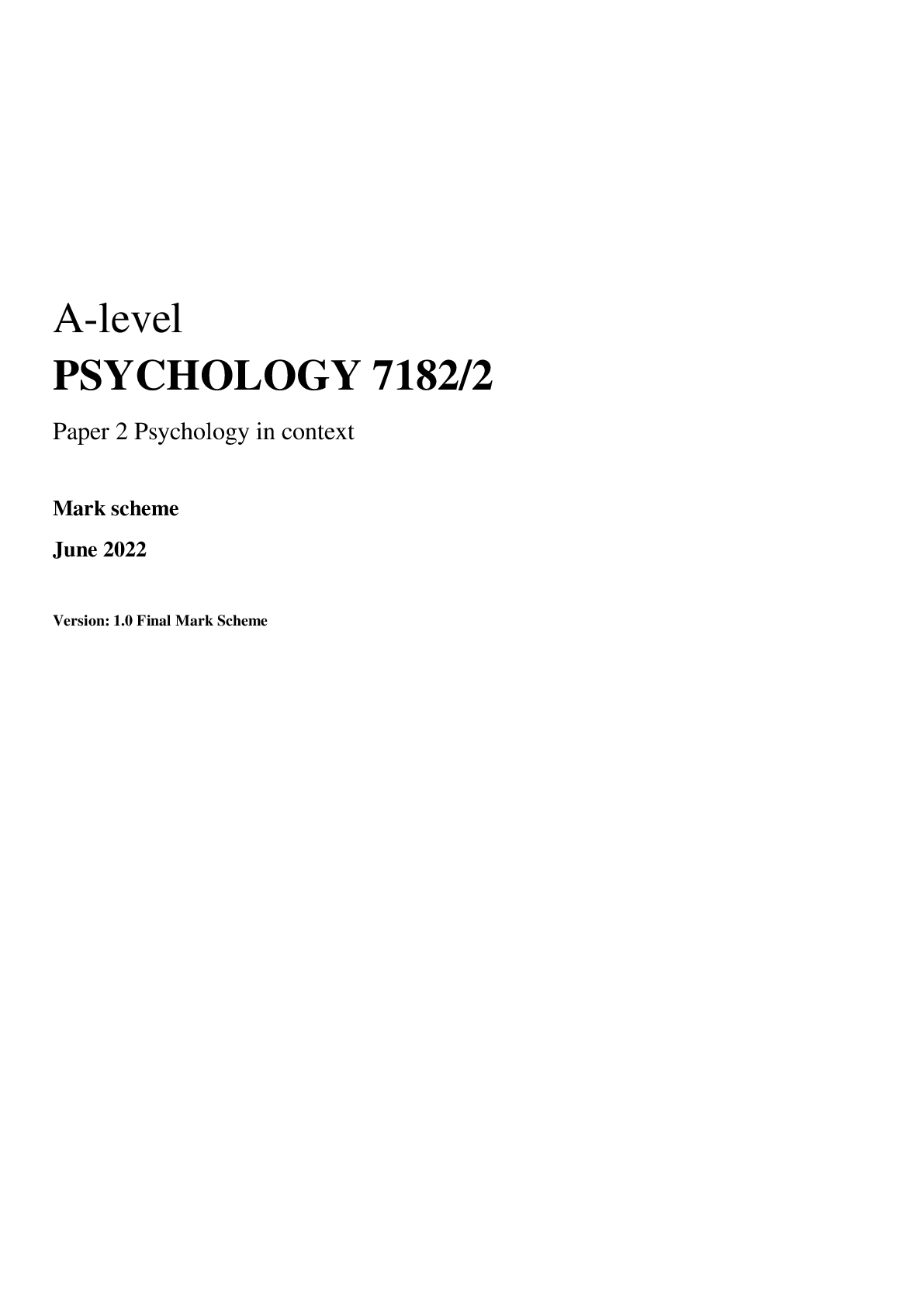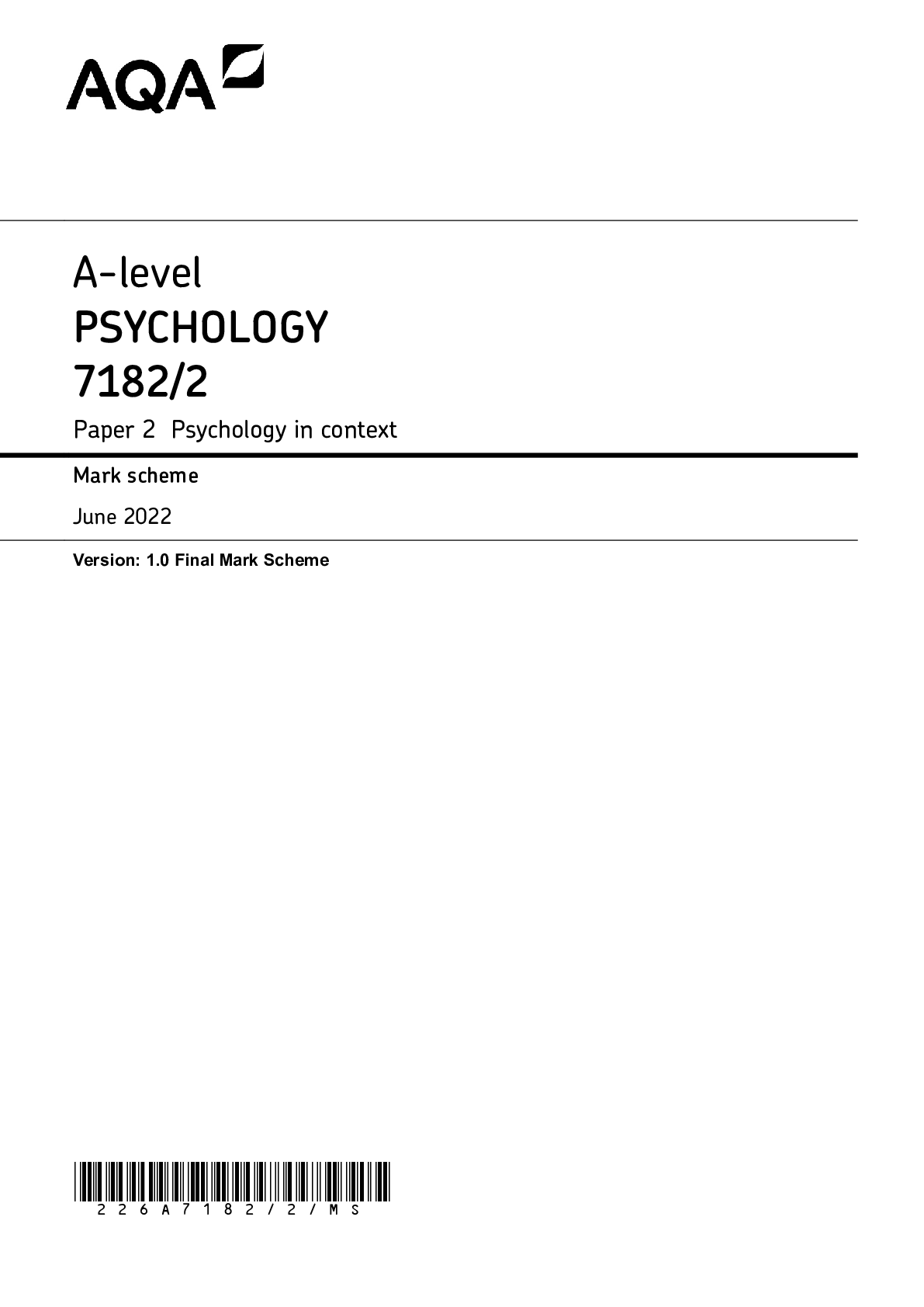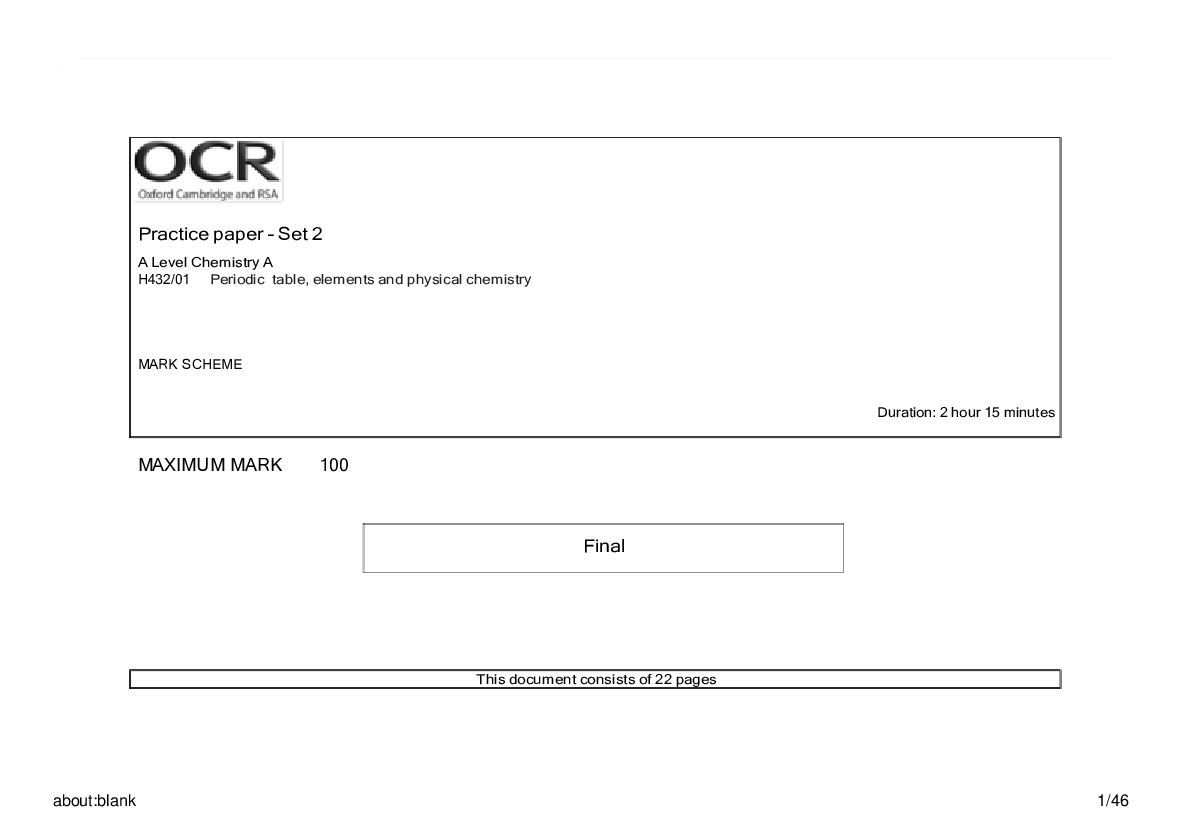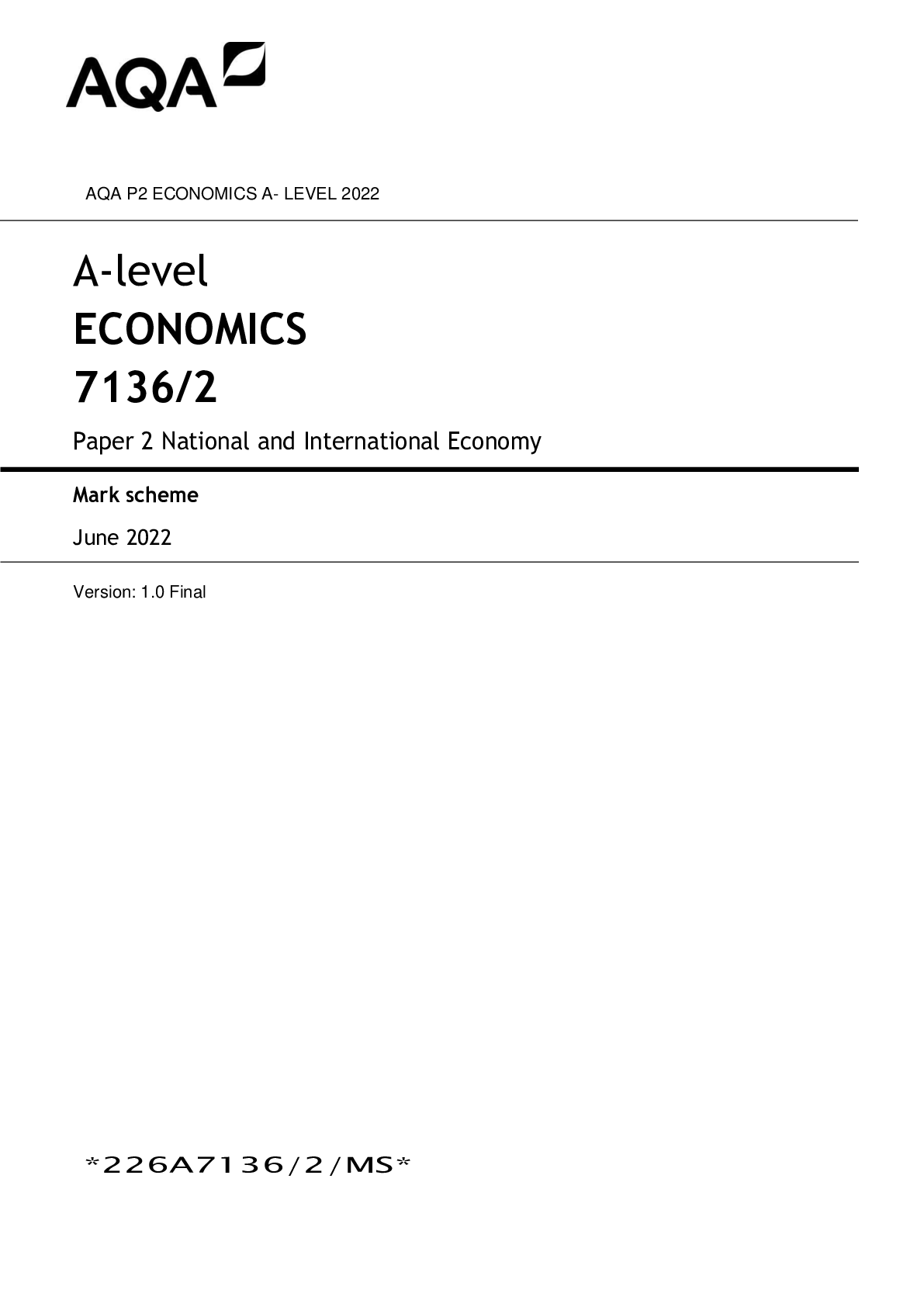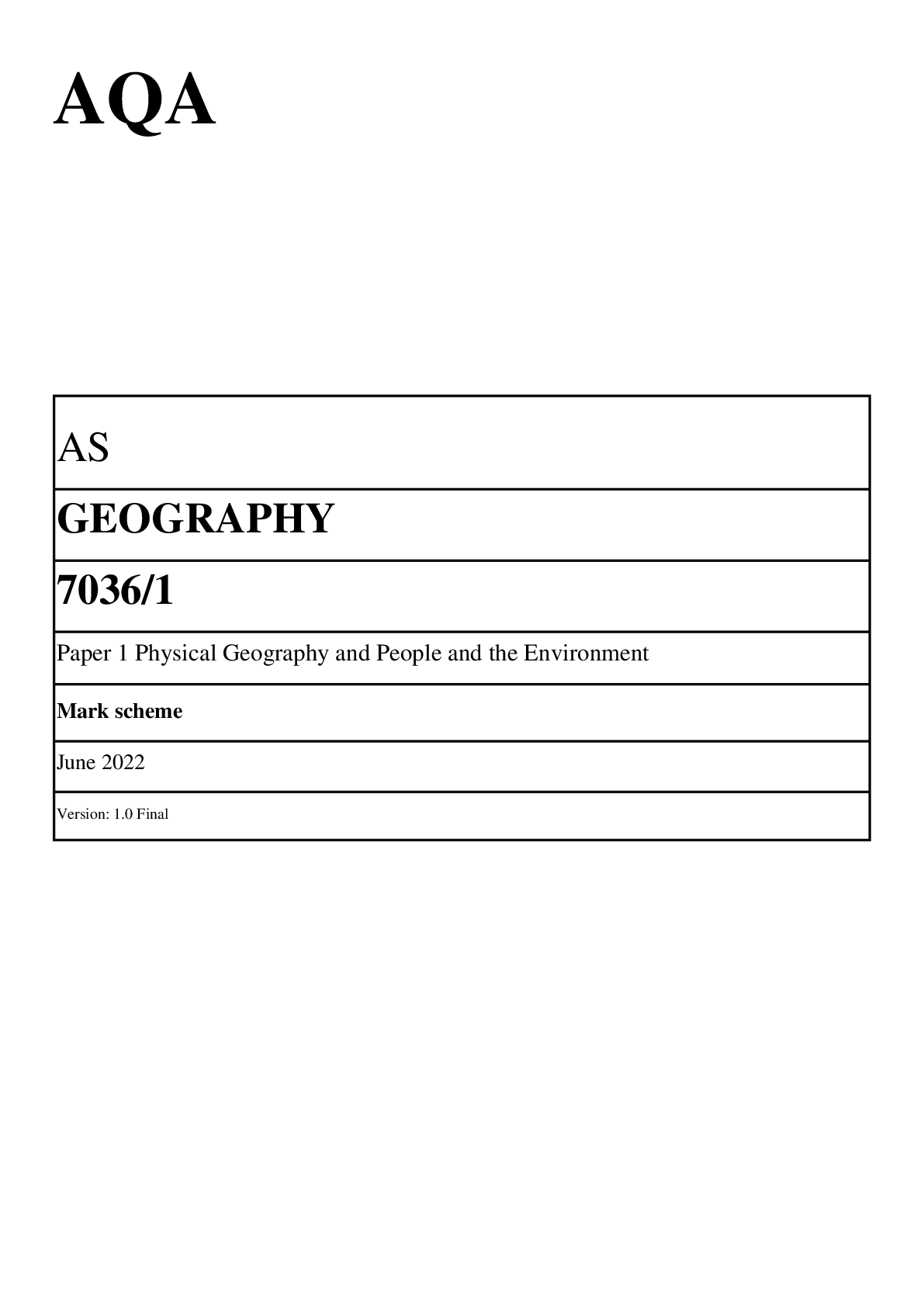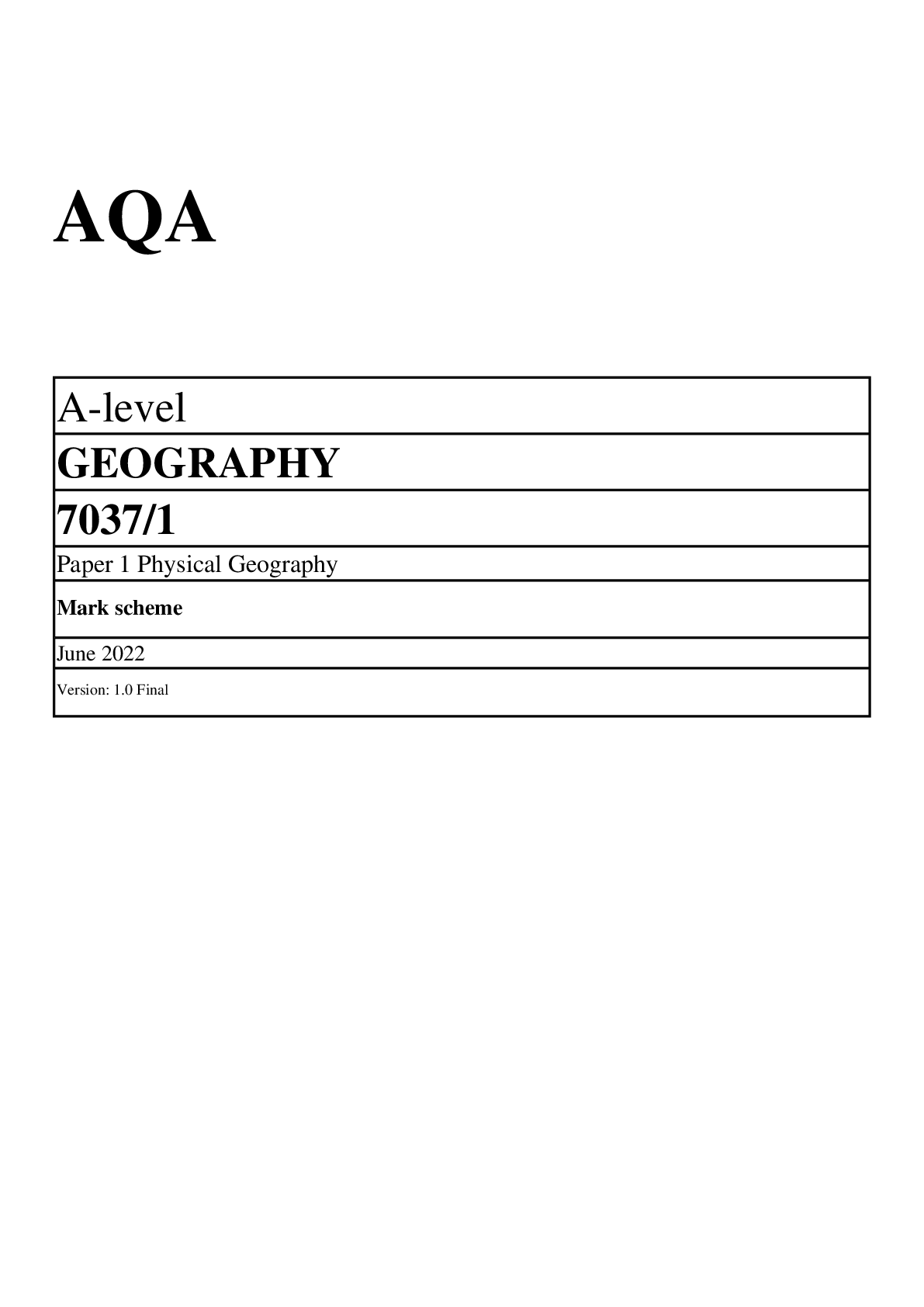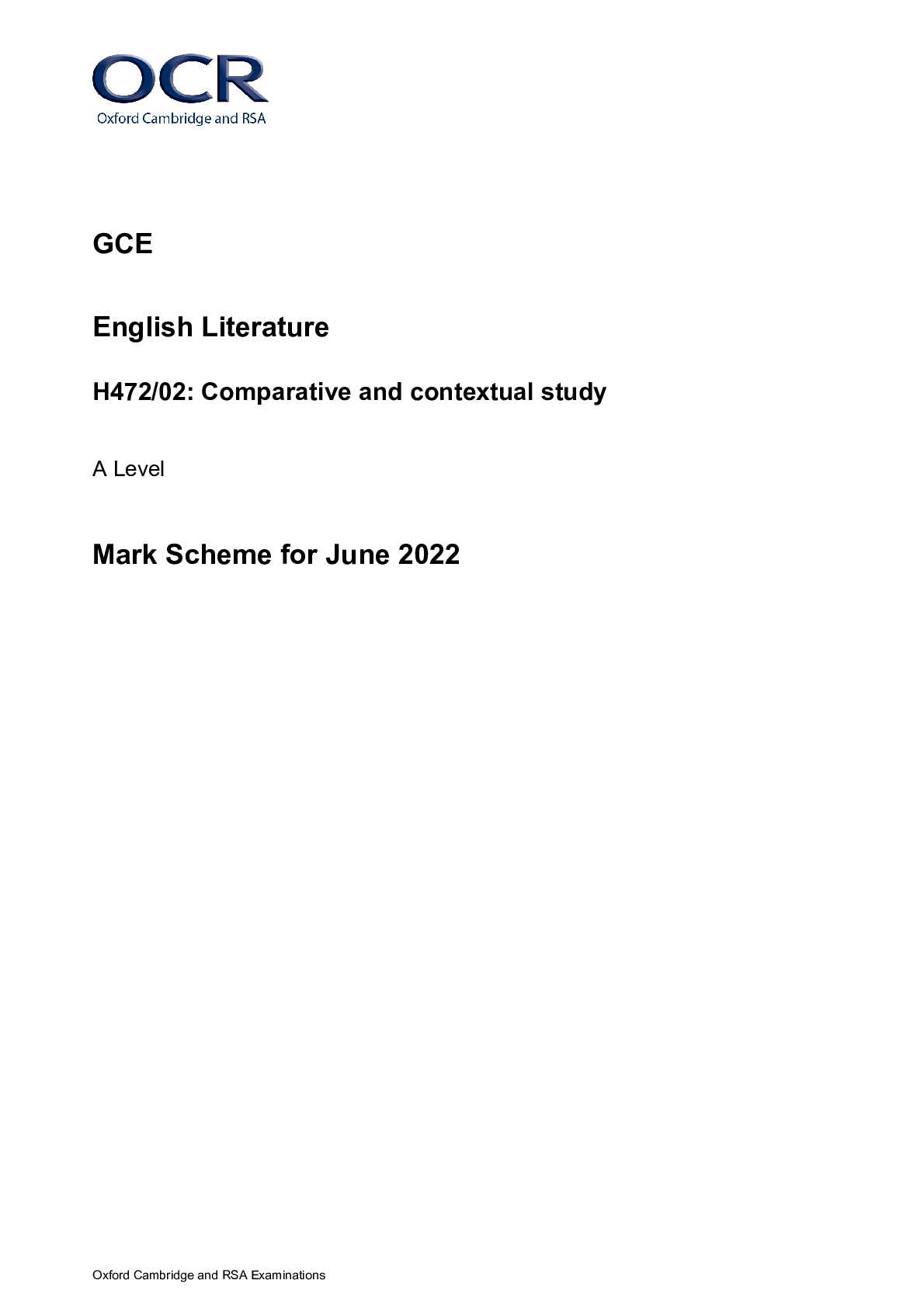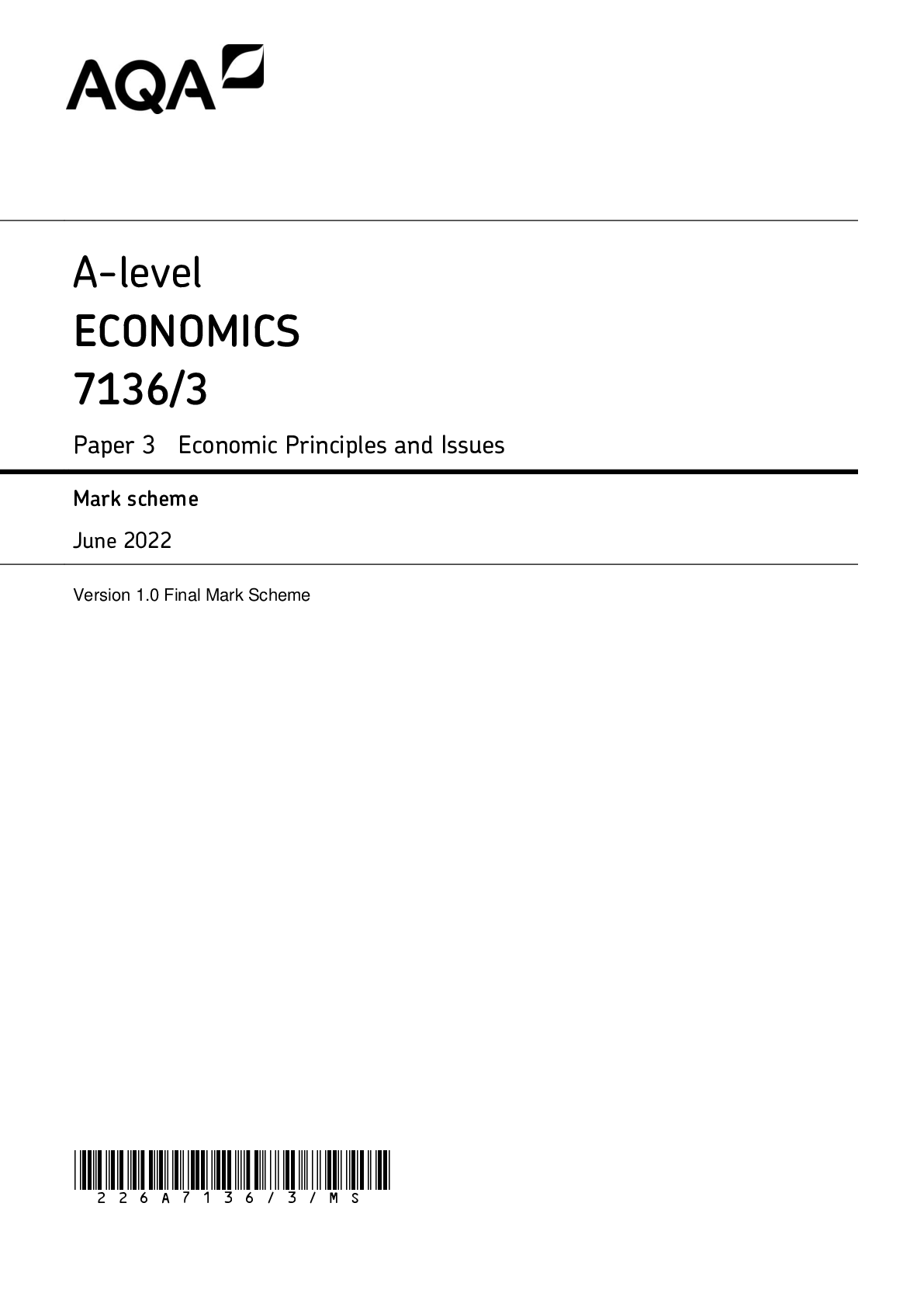Psychology > A-Level Mark Scheme > AQA PSYCHOLOGY 7182/2 PAPER 2 Mark scheme Specimen Material Second Set Final 2020A-level PSYCHOLOGY (All)
AQA PSYCHOLOGY 7182/2 PAPER 2 Mark scheme Specimen Material Second Set Final 2020A-level PSYCHOLOGY 7182/2 PAPER 2 Mark scheme Specimen Material Second Set
Document Content and Description Below
AQA PSYCHOLOGY 7182/2 PAPER 2 Mark scheme Specimen Material Second Set Final 2020A-level PSYCHOLOGY 7182/2 PAPER 2 Mark scheme Specimen Material Second Set FinalMark schemes are prepared by the... Lead Assessment Writer and considered, together with the relevant questions, by a panel of subject teachers. This mark scheme includes any amendments made at the standardisation events which all associates participate in and is the scheme which was used by them in this examination. The standardisation process ensures that the mark scheme covers the students’ responses to questions and that every associate understands and applies it in the same correct way. As preparation for standardisation each associate analyses a number of students’ scripts: alternative answers not already covered by the mark scheme are discussed and legislated for. If, after the standardisation process, associates encounter unusual answers which have not been raised they are required to refer these to the Lead Assessment Writer. It must be stressed that a mark scheme is a working document, in many cases further developed and expanded on the basis of students’ reactions to a particular paper. Assumptions about future mark schemes on the basis of one year’s document should be avoided; whilst the guiding principles of assessment remain constant, details will change, depending on the content of a particular examination paper. Further copies of this mark scheme are available from aqa.org.uk Copyright © 2015 AQA and its licensors. All rights reserved. AQA retains the copyright on all its publications. However, registered schools/colleges for AQA are permitted to copy material from this booklet for their own internal use, with the following important exception: AQA cannot give permission to schools/colleges to photocopy any material that is acknowledged to a third party even for internal use within the centre.MARK SCHEME – A-LEVEL PSYCHOLOGY PAPER 2 – 7182/2 - SERIES 3 of 16 Level of response marking instructions Level of response mark schemes are broken down into two, three or four levels, each of which has a descriptor. The descriptor for the level shows the average performance for the level. There are two, three or four marks in each level. Before you apply the mark scheme to a student’s answer read through the answer and annotate it (as instructed) to show the qualities that are being looked for. You can then apply the mark scheme. Step 1 Determine a level Start at the lowest level of the mark scheme and use it as a ladder to see whether the answer meets the descriptor for that level. The descriptor for the level indicates the different qualities that might be seen in the student’s answer for that level. If it meets the lowest level then go to the next one and decide if it meets this level, and so on, until you have a match between the level descriptor and the answer. With practice and familiarity you will find that for better answers you will be able to quickly skip through the lower levels of the mark scheme. When assigning a level you should look at the overall quality of the answer and not look to pick holes in small and specific parts of the answer where the student has not performed quite as well as the rest. If the answer covers different aspects of different levels of the mark scheme you should use a best fit approach for defining the level and then use the variability of the response to help decide the mark within the level, ie if the response is predominantly level 3 with a small amount of level 4 material it would be placed in level 3 but be awarded a mark near the top of the level because of the level 4 content. Step 2 Determine a mark Once you have assigned a level you need to decide on the mark. The descriptors on how to allocate marks can help with this. The exemplar materials used during standardisation will help. There will be an answer in the standardising materials which will correspond with each level of the mark scheme. This answer will have been awarded a mark by the Lead Examiner. You can compare the student’s answer with the example to determine if it is the same standard, better or worse than the example. You can then use this to allocate a mark for the answer based on the Lead Examiner’s mark on the example. You may well need to read back through the answer as you apply the mark scheme to clarify points and assure yourself that the level and the mark are appropriate. Indicative content in the mark scheme is provided as a guide for examiners. It is not intended to be exhaustive and you must credit other valid points. Students do not have to cover all of the points mentioned in the indicative content to reach the highest level of the mark scheme. An answer which does not contain anything of relevance to the question must be awarded no marks. Examiners are required to assign each of the students’ responses to the most appropriate level according to its overall quality, then allocate a single mark within the level. When deciding upon a mark in a level examiners should bear in mind the relative weightings of the assessment objectives (included for each question and summarised on page 16) and be careful not to over/under credit a particular skill. For example, in question 05 more weight should be given to AO3 than to AO1. This will be exemplified and reinforced as part of examiner training and standardisation.MARK SCHEME – A-LEVEL PSYCHOLOGY PAPER 2 – SERIES 4 of 16 Section A Approaches in Psychology 01.1 A phenotype is the result of the combined effect of …. Shade one box only. [1 mark] Marks for this question: AO1 = 1 B 01.2 Which one of the following statements is false? Shade one box only. [1 mark] Marks for this question: AO1 = 1 D 02 Referring to Bradley’s experiences, explain the role of mediational processes in learning. [4 marks] Marks for this question: AO2 = 4 Level Marks Description 2 3–4 The role of meditational processes relevant to Bradley’s situation is clear and mostly accurate. The material is used appropriately to explain Bradley’s experiences. The answer is generally coherent with effective use of specialist terminology. 1 1–2 The role of mediational processes relevant to Bradley’s situation is evident. The material is not always linked explicitly or effectively to Bradley’s experiences. The answer lacks accuracy and detail. Use of specialist terminology is either absent or inappropriate. 0 No relevant content. Possible content: Credit mediational processes relevant to Bradley’s situation eg mental/cognitive processes occur between stimulus (Bradley’s observation) and response (Bradley’s copying the behaviour) specific examples here are: attention, motivation, retention/memory, assessment of own ability Bradley is motivated to attend to the relevant information (is keen to play well) Bradley pays attention to the actions of the person he wants to copy (watches carefully) Bradley tries to remember the action so he can do the same (thinks about how he was holding the cue) Bradley considers his own ability to perform (thinks…whether he can do the same.) Credit other relevant information.MARK SCHEME – A-LEVEL PSYCHOLOGY PAPER 2 – SERIES 5 of 16 03 Describe Wundt’s role in the development of psychology [6 marks] Marks for this question AO1 = 6 Level Marks Description 3 5–6 Knowledge of Wundt’s role in the development of psychology is generally accurate and mostly well detailed. The answer is clear and coherent. Specialist terminology is used effectively. 2 3–4 Knowledge of Wundt’s role in the development of psychology is evident. There are some inaccuracies. There is some appropriate use of specialist terminology. 1 1–2 Knowledge of Wundt’s role in the development of psychology is limited and lacks detail. There is substantial inaccuracy/muddle. Specialist terminology is either absent or inappropriately used. 0 No relevant content. Possible content: Wundt known as ‘the father of psychology’ – moved from philosophical roots to controlled research Set up the first psychology laboratory in Liepzig, Germany in 1870s Promoted the use of introspection as a way of studying mental processes Introspection – systematic analysis of own conscious experience of a stimulus An experience was analysed in terms of its components parts eg sensations, emotional reaction etc. His work paved the way for later controlled research and the study of mental processes eg by cognitive psychologists. Credit other relevant information. 04 Briefly explain one strength and one limitation of the cognitive approach in psychology. [4 marks] Marks for this question: AO3 = 4 Strength: 1 mark for identification of a strength Plus 1 mark for explanation/elaboration eg why it is a strength of the cognitive approach. Limitation: 1 mark for identification of a limitation Plus 1 mark for explanation/elaboration eg why it is a limitation of the cognitive approach. Likely strengths: control/objectivity in research; use of models for ease of understanding; links to neuroscience and consequent applications Likely limitations: still requires inferences about cognitive processes; mechanistic approach to understanding human behaviourMARK SCHEME – A-LEVEL PSYCHOLOGY PAPER 2 – SERIES 6 of 16 05 Outline the psychodynamic approach in psychology. Discuss one or more differences between the psychodynamic approach and the humanistic approach. [8 marks] Marks for this question: AO1 = 3 and AO3 = 5 Level Marks Description 4 7-8 Outline of the psychodynamic approach is generally accurate. Discussion of difference(s) is thorough and effective. Answer is clear, coherent and well focused. Specialist terminology is used effectively. Minor detail and/or expansion of argument sometimes lacking. 3 5-6 Outline of the psychodynamic approach is evident. There are occasional inaccuracies. Discussion of difference(s) is apparent and mostly effective. The answer is mostly clear and organised. Specialist terminology mostly used effectively. Lacks focus in places. 2 3-4 Outline of the psychodynamic approach is present. Focus is mainly on description. Any discussion of difference(s) is only partly effective. The answer lacks clarity, accuracy and organisation in places. Specialist terminology used inappropriately on occasions. 1 1-2 Outline of the psychodynamic approach is very limited. Discussion of difference(s) is limited, poorly focused or absent. The answer as a whole lacks clarity, has many inaccuracies and is poorly organised. Specialist terminology either absent or inappropriately used. 0 No relevant content. Possible content – outline: The concept of the unconscious and role of unconscious in behaviour Tripartite structure of the personality – id, ego, superego Psychosexual stages of development Conflicts – Oedipus and Electra Defence mechanisms Psychodynamic approach to therapy – psychoanalysis Possible differences - discussion: Negativity of Freud in relation to the positive outlook of humanistic psychology Emphasis on repressed thoughts and emotions, and past experiences (Freud) versus emphasis on subjective experience of the present and personal growth in the future Emphasis on unconscious drives/motives versus conscious awareness and experience Psychic determinism (Freud) versus free will and rational choice Directive versus non-directive approach to therapy Not all of this is necessary for full credit. Credit other relevant information.MARK SCHEME – A-LEVEL PSYCHOLOGY PAPER 2 – SERIES 7 of 16 Section B Biopsychology 6 Outline the role of adrenaline in the fight or flight response. [4 marks] Marks for this question: AO1 = 4 Level Marks Description 2 3–4 Knowledge of the role of adrenaline in the fight or flight response is clear and mostly accurate. 1 1–2 Knowledge of the role of adrenaline in the fight or flight response is incomplete/partly accurate. For 1 mark there may be some detail of direct or general effects but not explicitly linked to fight or flight. 0 No relevant content. Possible content Adrenaline is released from the adrenal medulla in response to activation of the sympathomedullary pathway. Adrenaline has a range of effects on the body Direct effects of adrenaline – increase heart rate – constricts blood vessels, increasing rate of blood flow and raising blood pressure – diverts blood away from the skin, kidneys and digestive system – increases blood to brain and skeletal muscle – increases respiration and sweating The general effects of adrenaline – prepare the body for action, fight or flight, – increase blood supply/oxygen, to skeletal muscle for physical action – increase oxygen to brain for rapid response planning Up to 2 marks for accurate detail of the effects of adrenaline on the body eg outline of two different effects, or detailed account of one effect. 2 further marks for an account of the role of adrenaline in the fight or flight response ie providing a context for the various effects of adrenaline on the body (eg last two bullets).MARK SCHEME – A-LEVEL PSYCHOLOGY PAPER 2 – SERIES 8 of 16 7 Discuss how knowledge of hemispheric lateralisation and language centres in the brain has helped our understanding of cases such as Robert’s. Refer to Robert’s case in your answer. [16 marks] Marks for this question: AO1 = 6, AO2 = 4 and AO3 = 6 Level Marks Description 4 13–16 Knowledge of hemispheric lateralisation and language centres in the brain is accurate and generally well detailed. Discussion is thorough with effective reference to cases of aphasia. Answer is clear, coherent and focused. Specialist terminology is used effectively. Minor detail and/or expansion of argument sometimes lacking. 3 9–12 Knowledge of hemispheric lateralisation and language centres in the brain is evident. There are occasional inaccuracies. Discussion is apparent and reference to cases of aphasia is mostly effective. The answer is mostly clear and organised. Specialist terminology mostly used effectively. Lacks focus in places. 2 5–8 Some knowledge of hemispheric lateralisation and language centres in the brain is present. Focus is mainly on description. Any discussion and reference to cases of aphasia is only partly effective. The answer lacks clarity, accuracy and organisation in places. Specialist terminology used inappropriately on occasions. 1 1–4 Knowledge of biological explanations of offending behaviour is limited. Discussion is limited, poorly focused or absent. The answer as a whole lacks clarity, has many inaccuracies and is poorly organised. Specialist terminology either absent or inappropriately used. 0 No relevant content. Possible content Systematic research from Wernicke and Broca onwards has demonstrated that in most people language centres are lateralised to the left hemisphere Wernicke’s area seems to be responsible for the interpretation of speech – damage leads to receptive or sensory aphasia Broca’s area was thought to be responsible for the production of speech this is now thought to involve a wider network than just Bro [Show More]
Last updated: 1 year ago
Preview 1 out of 17 pages
.png)
Reviews( 0 )
Document information
Connected school, study & course
About the document
Uploaded On
Sep 05, 2022
Number of pages
17
Written in
Additional information
This document has been written for:
Uploaded
Sep 05, 2022
Downloads
0
Views
138


